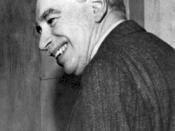Macroeconomics and it's Schools of Thought
Adam Smith founded economics as we know it today in 1776 with his work 'The Wealth of Nations'. Throughout the last two centuries economics has developed and consistently branched out into new and different areas. Though some may disagree, the two schools of thought that have had the most influence over economists past and present are Keynesian and Monetarist economics. Keynesian economics, derived from the theories of John Maynard Keynes, regards the economy as inherently unstable and requires active government intervention to achieve stability. A Keynesian economist assigns a low degree of importance to monetary policy and a high degree of importance to fiscal policy. Conversely the Monetarists believe the economy is in fact inherently stable. This view is fundamentally grounded in the belief of natural supply and demand in the market place and its ability to adjust and correct itself. The founder of modern Monetarism is Milton Friedman.
To this end there are many issues to this day in which these two schools agree and disagree upon such as the labour market, fiscal versus monetary policy and the influence of interest rates.
As I have said before John Maynard Keynes founded Keynesian economics. His work 'General Theory of Employment, Interest and Money' was written to the backdrop of the great depression of the 1930's. It set out a framework in which induced government to take a more active part in the growth of its nation. His ideas were based on some basic theories. For example he believed that people as a whole do not increase or decrease they're spending with the change in interest rates. This was in contrast to the classical view, which said that interest rates changed the pace of borrowing and spending. Keynes believed that a person would...


